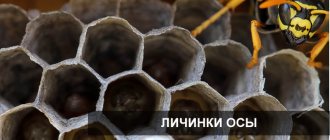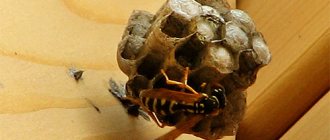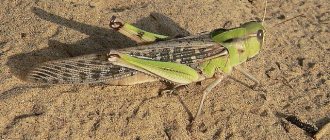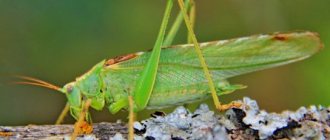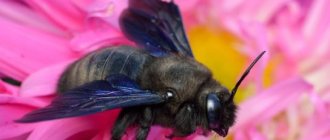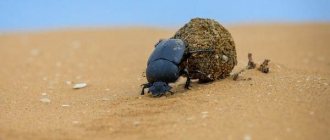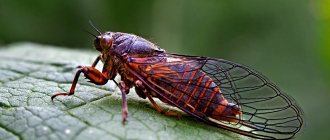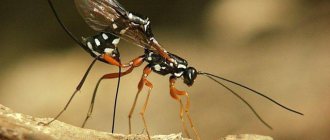Among the amazing creatures of nature, the scorpion woman occupies a worthy place. The arthropod insect has several characteristic features. The first is a beak-shaped outgrowth on the head, the second is the male’s genitals, curved upward like a scorpion’s sting. One of the oldest groups, according to the results of recent research, has more in common with fleas than with representatives of Diptera. Small and medium-sized scorpions prefer damp places and can be seen on the forest floor.
Description and features
The common scorpionwort (Panorpa communis) is a prominent representative of the order of scorpionworts. Panorpas, the group to which it belongs, feed on insects. They have an elongated, thin, yellow body with black spots or stripes on the back and lower abdomen. The body size reaches 13-15 mm.
The legs are long, consist of 5 segments, and there are 2 claws on the tarsus. The abdomen is cylindrical and consists of 10 segments. Females and males can be distinguished by the shape of the end of the abdomen. In females it is simply pointed. And the characteristic appearance of the end of the male’s abdomen gave the name to the entire order.
Its posterior end, consisting of 3 segments, is curved like the rising tail of a scorpion and has a reddish color. The last segment is greatly swollen, where its genitals are located. If you look closely, the males resemble a hybrid of a wasp and a scorpion. But this is only external. These insects have nothing to do with wasps or scorpions.
Female scorpions do not have a scary tail
One of the characteristic features of the entire group is the presence of a rostrum (proboscis in the front of the head). It is usually red in color. Its shape helps the insect pull food out of hard-to-reach places. After all, the fly does not hunt on the fly, and cannot pierce the bark, the rostrum is too soft. Therefore, he grew up so that she could skillfully and without interference dig among the grass, cobwebs and leaves.
Behind these organs is the gnawing mouthparts. Its longest part is the maxilla (the second pair of jaws, which performs the function of tearing, piercing prey and grinding food). The stipes or stem is the central part of the entire lower jaw and is the basis for all elements of the maxilla, the so-called load-bearing rod.
In these flies it holds the back wall of the proboscis, adhering closely to it. The appearance and shape of the mandibles (in other words, the mandibles, the upper paired jaws of the oral apparatus) depends on the feeding habits. If we have a herbivorous insect in front of us, the mandibles are thick and short, containing two teeth, and sometimes more.
In predators, these elements are flat, cut along an oblique line, with one cutting tooth. They work like scissors. In scavengers, the mandibles are something between the two. The antennae consist of segments, the number of which ranges from 16-20 to 60. They can be very thin, thread-like, or clearly defined.
The antennae are of great importance in identifying food, as well as in finding a sexual partner. They are also important and very sensitive organs that allow the insect to adequately perceive the environment and chemical processes both outside and inside this creature.
They clearly detect changes in temperature, changes in the acid component, and the presence of gases. They react to the state of the body itself, which allows you to leave an uncomfortable habitat in time. This is called chemoreception.
Probably, many devices of the future could be equipped with such sensitive devices, which would make it much easier for people to live and work in various unfriendly conditions. The chest with both the head and the abdomen is in a movable joint.
The wings, consisting of two pairs, have a beautiful mesh pattern and clearly visible pterostigmas (thickenings at the leading edge of the wing, closer to the apex). The wing tissue (membrane) can be completely transparent or matte spotted, most often covered with short hairs.
Swing up to 30 mm. The female has darker wings; the male has almost white wings with dark spots. The wings are not adapted for long flights, but the legs are in most cases used for jogging. Due to their long legs, many species of this insect are confused with mosquitoes.
At the base of the wings there are faceted (multifaceted) eyes. They have color vision and also detect UV rays. Each of the elements of such an eye - the ommatidium - has the shape of a cone, tapering towards the center of the eyeball. There they are connected by vertices. And with their bases they form a mesh surface.
Each ommatidia fixes a limited small area, but together they cover the entire object as a whole. The Scorpio woman in the photo looks both graceful and menacing. Beautiful openwork wings that resemble stained glass add grace. And the danger comes from the curved “scorpion” tail, as well as the elongated beak-rostrum, with which the scorpion fly kills its prey.
Who are Scorpio women?
The structure of the head is characteristic of the order - the front part has turned into a rostrum. This beak-like outgrowth is formed from the chitinous capsule covering the forehead (clypeus) and subgenes. The size of the rostrum in different types of scorpionfish ranges from 2-3 mm to complete absence. The mouthparts are of the gnawing type, its longest element being the maxillae. A pair of jaws is designed for tearing prey.
The structure of the lower jaw (mandibles) depends on the diet of the insect. In predatory species, the mandibles resemble scissors - they are flat, long, and obliquely cut. The jaws of herbivores are short and thick with two teeth.
Scavengers have an intermediate mandible shape. On the sides of the head there are large compound eyes. Between them are placed three simple eyes and antennas. The antennae of scorpions are olfactory receptors; the organ detects various odors, directing the insect to a food source or mating partner. The bases of the antennae are yellow and the base color is brown.
Information. About 800 species of living and 370 fossil scorpions have been found in the world.
Features of the structure of the wings
Does a scorpion girl have wings? Most species have two pairs of long wings with developed venation. When at rest, they are laid horizontally, with the edges moving apart. The color is spotty or transparent. The membrane is covered with fine hairs. Insects fly poorly and can only cover a short distance. Almost a fifth of known species have reduced wings, and in some they are completely absent. During flight, the insect's narrow wings move alternately. To an outside observer, this movement looks uneven. The scorpion fly seems to fall for a moment into an air hole.
Kinds
These insects are considered an ancient and primitive form, which was widespread already in the Paleozoic and Mesozoic eras. The scorpionfish order includes 23 families, of which 14 can currently be considered extinct. Approximately 770 species are now known, including 369 fossils.
The most famous families from this order include mosquitoes, glaciers and true scorpions.
1. Mosquitoes (bittaki) - a family of insects from the order of scorpions. There are about 270 species of them, found everywhere. The body is thin, the legs are disproportionately elongated. They, like predatory representatives of the order, have long mandibles, with one tooth, cut along an oblique line. They can often be seen hanging from plants, clinging to one or both of their long front legs.
They lie in wait for prey, which they easily grab with their hind limbs, similar to the legs of a praying mantis. These legs have large claws, two spurs on the shins and are ideally suited for grasping prey. Such a scorpion fly in the photo can easily be mistaken for a long-legged mosquito, especially when stationary.
2. Glaciers (boreids) are a small family with about 30 species. All species are boreal, i.e. relating to the natural conditions of the Northern Hemisphere between 40 and 60º north latitude, with short, hot summers and long, cold winters. The name comes from the name of the god of the north wind from Greek mythology - Boreas.
Recent studies have shown that glaciers are more related to fleas than to other scorpions. It is not difficult to recognize them; males are characterized by the rudiments of wings, but they do not fly, but jump, since wings do not grow. And females don’t even have rudiments, but they have a long ovipositor. The size of insects is very small, 2-4 mm.
They have a beak-shaped elongated head, which has a gnawing mouthparts. They move by jumping like grasshoppers, their hind legs are hopping. In one jump they can cover a distance of 50 times their body length. During the thaw, they appear in the snow near places overgrown with mosses, the young shoots of which they feed on.
This is the main difference between boreids and other scorpios - they are vegetarians. Their larvae are usually white, develop under a layer of mosses, and eat the roots of these plants. The larvae live for 2 years. They die in a warm environment, which is optimal for other species.
3. True scorpions (panorps) are about 9-25 mm in length. The mouthparts are gnawing and are located on the beak-shaped head, which is curved downwards. There are about 420 species. In Europe, 16 species are known, another 12 species live in Sumatra and Java, 136 species inhabited South Asia, 269 species, which include the common scorpionfish, are found in Europe and North America. There are 3 more species that are little studied.
Spreading
The common scorpionfish is found throughout Europe and Russia. The main habitats are moist deciduous forests, meadows and caves. Some species of scorpionfish live in semi-deserts. One of the families - glaciers - is found in the Northern Hemisphere. These are small wingless insects that move by jumping. They feel great in the snow, but cannot tolerate heat.
Information. Autumn and German scorpions are included in the Red Book of the Leningrad Region.
Lifestyle and habitat
The scorpion insect loves damp places, choosing shady thickets of bushes near water, wet glades, and damp meadows. It lives in Europe, North America (Canada, Mexico and the USA). There are 5 species of common scorpionfish in Russia, 3 of which are included in the Red Book of the Leningrad Region.
These insects fly slowly and reluctantly, over short distances. Flight involves both pairs of wings, the alternating flapping of which helps the insect stay in the air. However, at the first opportunity they try to sit in the grass and get lost. They also hide from enemies among the grass and under rotting leaves.
A scorpion bite is safe for humans, since it is not poisonous, and it does not have a sting, which remains in the wound after the bite. True, it may seem painful, especially where the skin is thin. Allergy sufferers should be careful in the habitats of these insects.
The concept of “ the sting of a female scorpion ” is rather a colorful term for computer players who are fond of modern quests. The proboscis of this fly, with which it provides food for itself, is more of a “snout” than a sting, although it has an ominous appearance.
Sexual dimorphism
The male and female common scorpionfish are easily distinguished by the structure of the end of the abdomen. In females it is pointed, while in males the three segments are colored red and curved upward. The outer one is greatly inflated, and at the end there is a claw-shaped organ of copulation. The threatening appearance of the appendage evokes an association with the poisonous sting of a scorpion. But this is a protective mimicry from enemies; in fact, it is harmless. Who might be scared off by the resemblance to a Scorpio? It affects highly organized animals, such as birds.
Nutrition
All of these flies, except the glaciers, are predators. But, contrary to popular belief, they do not attack living insects, but willingly feed on dead and wounded, as well as rotting plant remains. In addition, they do not disdain the meat of deceased vertebrate animals and bird droppings.
The larvae predominantly have the same diet. In adult individuals, nectar and flower petals, as well as berry juice, are added to the menu. For example, in the south of Western Siberia they sometimes cause great damage to the silver currant crop. Flies simply devastate ripe berries, sucking the juice out of them.
Their famous “proboscis” comes in very handy here; it is what helps draw out the delicious, juicy pulp. However, despite some inconveniences, these insects are more harmless than harmful. They are very useful as little scavengers that rid areas of dead insects.
Reproduction and lifespan
Scorpions are a detachment of insects with complete transformation (metamorphosis). In essence, this process is an internal and external restructuring of the body throughout life. Complete metamorphosis or holometamorphosis is four to five stages from birth to adulthood: eggs, larvae, pupae, sometimes prepupae, and adult.
The main difference between a complete cycle and an incomplete one is the passage through the pupal stage. Most often, scorpion larvae are completely different from adult individuals, which is why they are called true larvae. Undoubtedly, holometamorphosis can be considered an evolutionary leap in the development of such insects, since initially the origin and development of almost all insects was based on incomplete transformation.
The progress of transformation into the intermediate pupal stage proves the amazing adaptability of many insects to external conditions. Apparently, the larva was not always ready to survive in difficult conditions. Perhaps it was this additional stage that helped our heroine adapt to the changing climate and other difficult external circumstances.
During the breeding season, males attract mates by spreading pheromones around them. These insects have a peculiar courtship ritual. The male brings a dead insect to his girlfriend as a gift. The female partner eats the treat during mating. The larger the food size, the longer the process takes.
Moreover, if there is a large concentration of flies and there is a choice, the females allow only applicants with a large gift to mate. Losers with a small offering are only in demand if there are few other “suitors” around. This is probably natural selection. A large gift is usually brought by large males, so females choose a larger father of their offspring, which ensures the evolutionary process.
The female lays eggs in heaps in moist soil and under fallen leaves. She places them with a proboscis, burying them in the top layer of soil. They have an oval shape, size about 2.5 mm, quantity is about 100 pieces. Actually, this is its main parental function - to lay eggs in the most suitable conditions for the development of larvae.
This ends all concern for future offspring. After 8 days, the larvae hatch and reach full growth within a month. The larvae are very similar to caterpillars; they are thick and inactive, but often crawl out into the light to find food. Like adult flies, they feed on plant and animal remains, as well as moss and roots.
The head of the larva is hard, 2 antennas are already visible on it. Very remarkable are the eyes, the number of which they have is greater than that of all other insect larvae. There are about 30 of them on each side, they form a cluster that already resembles a compound eye. The oral apparatus is well developed. The caterpillar is about 20 mm long. Consists of convex segments.
The first three segments contain the thoracic limbs. The body of the caterpillars is covered with warts. The larvae live in horseshoe-shaped burrows dug in the upper layers of the soil. To pupate, the caterpillar burrows deeper into the ground. Therefore, the transformation into a pupa takes place in a cozy earthen cradle. However, the pupa does not always immediately begin to transform into the adult stage; under unfavorable conditions, it enters diapause.
This is the great wisdom of this stage. Additional insurance for survival. If everything happens normally, after 2 weeks the pupae turn into an imago - an adult insect. During the summer, two generations can develop, of which the last overwinters in the larval or pupal stage. Adult insects live for one season, from May to September.
Interesting Facts
- The Scorpio woman has an important and interesting feature for survival in nature - mimicry. She has no poison and no armor, so she has to either become invisible, imitating a twig or leaf, or pretend to be poisonous and dangerous. The body coloring, curved “scorpion tail” and long trunk help her in this.
- Some male scorpions give a drop of their own saliva as a courtship gift. The friend eats it with pleasure. If the offering turns out to be small, the male risks not having time to complete the mating process, since the obstinate girlfriend does not remain in place for a second after eating the presentation. For lack of an alternative, he repeatedly regurgitates saliva to prolong the process.
- The image that an insect sees due to the faceted structure of the eye is mosaic and straight, in contrast to the image received by a person. Ours is upside down.
- Probably, many could see huge screens located in shopping centers, on the streets and squares of cities, at the ends of buildings. They broadcast an advertisement or other entertainment, and their action is based on a faceted display, when each screen shows its own small element, and together a complete picture is obtained. The amazing visual organs of insects like the scorpion fly taught us this method of displaying a large image.
- It is very interesting to watch the flight of this insect. From the outside, it looks uneven and “shimmering” due to the alternately flashing dark tips of the wings.
- The study of fossil forms close to scorpionflies during the examination of Permian deposits of the Paleozoic era, as well as comparison with modern representatives, allowed scientists to assume that these flies are close descendants of dipterans, lepidopterans and caddisflies.
